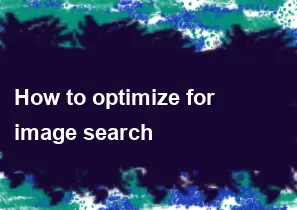How to optimize for image search

Optimizing for image search involves making your images more discoverable by search engines. Here are some tips to help you optimize for image search:
Use Descriptive Filenames:
- Rename your image files with descriptive, keyword-rich filenames. Avoid generic names like "image001.jpg" and instead use names that describe the content of the image.
Alt Text:
- Add descriptive alt text to your images. Alt text is a text alternative to an image and is used by search engines to understand the content of the image. Include relevant keywords, but make sure it accurately describes the image.
Image Captions:
- If applicable, add captions to your images. Captions provide additional context and can contain keywords that enhance the image's relevance.
Image Sitemap:
- Create an image sitemap and submit it to search engines. This helps search engines discover and index your images more effectively.
Choose the Right File Type:
- Use the appropriate file format for your images. JPEG is suitable for photographs, while PNG is better for images with transparency. Choose the right format to balance image quality and file size.
Image Size and Compression:
- Optimize your images for web by resizing them appropriately and compressing them without sacrificing too much quality. Smaller file sizes result in faster loading times, which is beneficial for both user experience and search engine rankings.
Responsive Design:
- Ensure your website is mobile-friendly and uses responsive design. Google prioritizes mobile-friendly websites, and this includes images that are optimized for different screen sizes.
Surrounding Text:
- Include relevant text around your images. Search engines use the context of the surrounding text to understand the content of the image.
Image Hosting:
- Host your images on a reliable and fast server. This can positively impact page loading times, contributing to a better user experience and potentially improving search rankings.
Social Media Optimization:
- Share your images on social media platforms with appropriate descriptions and hashtags. Social signals can indirectly impact search engine rankings.
Schema Markup:
- Implement schema markup for your images. This structured data helps search engines understand the content and context of your images, providing more information for users.
Backlinks:
- Acquire high-quality backlinks to your pages with images. Backlinks remain an essential factor in search engine algorithms.
Remember that optimizing for image search is part of an overall SEO strategy. Focus on providing valuable content and a positive user experience, as these factors also play a crucial role in search engine rankings.
-
Popular Post
- How to optimize for Google's About This Result feature for local businesses
- How to implement multi-language support in an Express.js application
- How to handle and optimize for changes in mobile search behavior
- How to handle CORS in a Node.js application
- How to use Vue.js with a UI framework (e.g., Vuetify, Element UI)
- How to configure Laravel Telescope for monitoring and profiling API requests
- How to create a command-line tool using the Commander.js library in Node.js
- How to implement code splitting in a React.js application
- How to use the AWS SDK for Node.js to interact with various AWS services
- How to use the Node.js Stream API for efficient data processing
- How to implement a cookie parser middleware in Node.js
- How to implement WebSockets for real-time communication in React
-
Latest Post
- How to implement a dynamic form with dynamic field styling based on user input in Next.js
- How to create a custom hook for handling user interactions with the browser's device motion in Next.js
- How to create a custom hook for handling user interactions with the browser's battery status in Next.js
- How to implement a dynamic form with dynamic field visibility based on user input in Next.js
- How to implement a dynamic form with real-time collaboration features in Next.js
- How to create a custom hook for handling user interactions with the browser's media devices in Next.js
- How to use the useSWRInfinite hook for paginating data with a custom loading indicator in Next.js
- How to create a custom hook for handling user interactions with the browser's network status in Next.js
- How to create a custom hook for handling user interactions with the browser's location in Next.js
- How to implement a dynamic form with multi-language support in Next.js
- How to create a custom hook for handling user interactions with the browser's ambient light sensor in Next.js
- How to use the useHover hook for creating interactive image zoom effects in Next.js